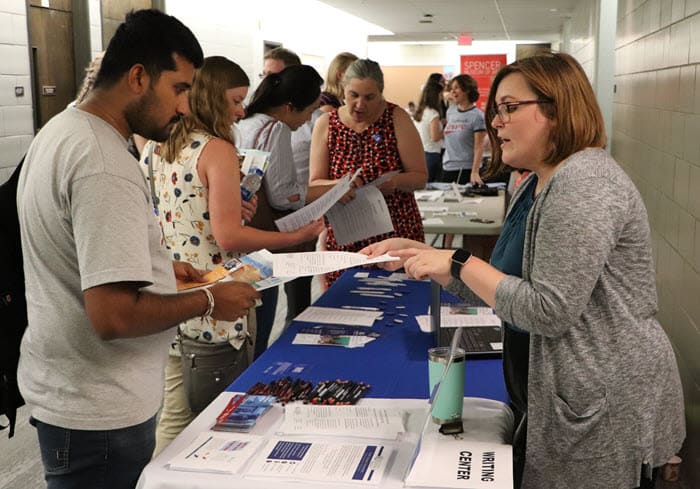By Doug Ward
The beginning of an academic year is a time of renewal. Our courses and our students start fresh, and we have an opportunity to try new approaches and new course material.
The beginning of an academic year is also a time for sharing advice, information, experiences, and insights. Here are some interesting tidbits I think are worth sharing.
Motivating students (part 1)
Aligning course goals with student goals is an important element of motivating students, David Gooblar, a lecturer in rhetoric at the University of Iowa, writes in The Chronicle of Higher Education.
Many students say they are motivated by grades – actually, many seem obsessed with grades – but that type of motivation doesn’t benefit them intellectually in the long term.

To help stimulate intrinsic motivation, Gooblar uses a low-stakes writing assignment in which students explain their goals for the course and how they hope the course will benefit them in the long term. Gooblar draws on those goals to adapt his class during the semester. Flexibility is important, he says, because it helps show students that he is willing to respond to their needs. That can be a powerful motivator.
I have also had success with having students write about their goals. I frame that in terms of learning goals, explaining to students that I have goals for the class but that I want them to pursue individual goals, too.
Most students struggle with writing individual learning goals because they have never had to think about learning as something they have control over. That thought makes them uncomfortable. They generally see school as a place where someone tells them what to do. I have found that waiting until the second or third week of class makes the process go more smoothly. By then, students have a good sense of what the class is about and they generally offer more thoughtful goals than they might in the first week.
Returning to those goals later in the class is important. I have students reflect on their learning goals at midterm, revising them if they wish, and again at the end of the class. That helps students assess what they have gained intellectually and what they still need to work on. It gives them a sense of accomplishment and helps them gain confidence in self-guided learning. It also gives me additional assessment information, as I ask students to explain which elements of the class helped them learn the most and which didn’t work as well.
Motivating students (part 2)
Shannon Portillo, associate professor of public affairs and administration, offers additional advice for motivating students.
Writing in Inside Higher Ed, Portillo, who is also the assistant vice chancellor for undergraduate programs at the Edwards Campus, has students help set guidelines for class engagement, using the exercise to help them feel invested in the class from the start.
At the end of the class, she asks students to evaluate their participation. They give her a suggested grade on their participation and provide evidence to back it up. She doesn’t always agree with their assessment, and ultimately determines the grade herself. Men tend to give themselves high marks, she says, while women tend to be more critical of themselves. The evaluation process helps students reflect on their contributions to the class and on their own learning.
Motivation (part 3). Faculty Focus offers additional tips on motivating students, including offering good feedback; helping students understand how learning works; providing engaging course materials and activities and explaining their relevance; and making greater use of cooperative and collaborative work.
Technology can help, but …
In a survey by Campus Technology, 73 percent of faculty members said that technology had made their jobs easier and 87 percent said it had improved their ability to teach. On the other hand, 19 percent said technology had made their job harder or much harder.
The survey did not say how technology had made things more difficult, but a comment on the article blamed it on a lack of training that ties pedagogy to the use of technology. That makes sense, but sometimes instructors fail to take advantage of the many available resources. KU has many resources for learning technology, including desk-side coaching and frequent workshops.
Student writing: No help needed?

In a recent survey by the Primary Research Group, only 8 percent of freshmen and sophomores said they thought they needed help with grammar and spelling. Yes, 8 percent.
Just as troubling, 46 percent of all students said they needed no additional writing instruction in their college classes.
Apparently, those 46 percent haven’t read any of the papers they have turned in or the email messages they have sent.
My intent isn’t to bash college students. Rather, it’s to remind instructor that as we help students, we sometimes need to remind them that they need our help and that resources like the KU Writing Center can provide crucial assistance.
The survey was reported by Inside Higher Ed.
Mental health and students
A growing percentage of students say they suffer from depression, anxiety and other mental health issues. That holds true for both undergraduates and graduate students.
At KU, for instance, Counseling and Psychological Services reported year-over-year increases in visits of 1 percent (November) to 73 percent (May) in the 2017-18 academic year.
One of the most important things faculty members can do is to pay attention to students and help them find the resources they need. Make sure that students know about Counseling and Psychological Services. I’ve made several calls to CAPS over the years, helping students schedule appointments with counselors. CAPS has other resources like drop-in hours with peer educators and group therapy sessions.
The Office of Student Affairs is another important resource. Its website provides an extensive list of advice and services for students and faculty members.
The Conversation noted recently that two of the biggest challenges to helping students with psychological issues are reluctance to talk about mental health and a reluctance to reach out for help. Instructors can help break down that stigma by being empathetic and accessible. They shouldn’t try to be psychological counselors. That’s not their role. They can listen to students, though, offer empathy and support, and help them take that first step toward getting help.
A final thought
A quote from Ryan Craig, managing director of University Ventures and author of A New U: Faster + Cheaper Alternatives to College, helps put issues of student mental health, attitude and motivation into context. In an interview with EdSurge, he said:
“We have developed this cult that you’re either going to go to college or if you don’t, maybe you’ll end up on Skid Row. I’m being a little facetious—but not that facetious. It literally has evolved to that point. A bachelor’s degree is the ticket to success and not having a bachelor’s degree is opposite.”
Doug Ward is the associate director of the Center for Teaching Excellence and an associate professor of journalism. You can follow him on Twitter @kuediting.